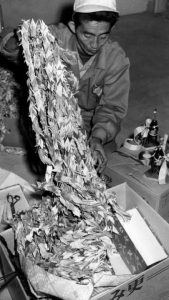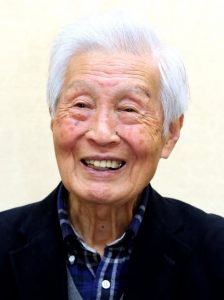My guidepost, Hiroshima pioneers: Shinichiro Kurose, 82, honorary chair of Hiroshima YMCA speaks about Ichiro Kawamoto, facilitator of Hiroshima Paper Crane Club
May 16, 2023
Supported A-bomb Dome preservation campaign behind the scenes
by Hiromi Morita, Staff Writer
Shinichiro Kurose was engaged in peace education at Hiroshima schools over many years. “Looking back, everything in my life has been driven by encounters with other people,” said Mr. Kurose. Among the many encounters he had, the most impactful was that with Ichiro Kawamoto (1929–2001), facilitator of the Hiroshima Paper Crane Club.
In 1969, when Mr. Kurose began work as an English teacher at Hiroshima Jogakuin Junior and Senior High School, located in the city’s Naka Ward, he made the acquaintance of a member of the school staff. That lean man of small stature was Mr. Kawamoto. Quietly, Mr. Kawamoto worked hard at the school. After his work was finished, he would tie to his bicycle a cardboard box containing towels and soaps he had collected on his own and pay visits to Korean A-bomb victims who had been hospitalized. His was later transferred to Peace Memorial Park, in Hiroshima’s Naka Ward, to clean the area around the Children’s Peace Monument, work that he continued on a daily basis.
Mr. Kurose had heard about Mr. Kawamoto, who had supported the campaign to erect the Children’s Peace Monument (in 1958) and other activities, before they first met, and he believed Mr. Kawamoto to be genuine and authentic, not superficial.
Mr. Kawamoto was born in Lima, the capital city of Peru, where his parents had immigrated. At the age of two, he and his mother returned to Japan after his father’s death, but later his mother also died of illness. In 1943, he began to live with his father’s family in present-day Saka-cho in Hiroshima Prefecture. On August 6, 1945, he avoided direct effects from the atomic bombing because he was at a power plant in Saka-cho. In the evening on that day, however, he entered the city to help with rescue operations. For days on end, he provided aid to the wounded in the ruins of Hiroshima. That experience appears to have determined the direction of his life after the war.
Mr. Kawamoto formed an A-bomb survivors’ organization in the early days after the atomic bombing together with others including Kiyoshi Kikkawa, a survivor nicknamed “Atomic Bomb Victim No. 1” who died in 1986. He quit his job at the power plant to dedicate himself to volunteer peace activities, striving to assist A-bomb survivors while continuing his work as a day laborer. Following the death from leukemia in 1955 of Sadako Sasaki, who had experienced the atomic bombing when she was two, he proposed that her classmates erect a monument in Sadako’s honor and lent his support to a fund-raising campaign led by the children. After completion of the monument, he became deeply involved in the peace activities of the Hiroshima Paper Crane Club, which placed students and children at the forefront, while working as the club’s facilitator.
His stance did not change even after he started work as a school staffer at Jogakuin Junior and Senior High School in 1967. If visitors would come to Hiroshima from overseas, he would pick them up at the train station and guide them with the help of some of the children. He took photographs of that activity, printed them at his own expense, and distributed the prints to the children’s parents and guardians.
Mr. Kawamoto always worked behind the scenes, and adoring students used to fondly refer to him as “Uncle Kawamoto.” Some people, however, became wary of his work style, which did not rely on existing organizational frameworks. He was sometimes harshly criticized by others who accused him of exploiting children. Mr. Kawamoto, however, was stubborn enough to stick silently to his beliefs.
Mr. Kurose and his wife, Teiko, who died in 2013, supported Mr. Kawamoto by translating letters for him that had arrived from overseas and providing him with box lunches. Each time one of the lunchboxes was returned after it had been washed clean, a small item, such as a thank-you note written on the blank side of a leaflet or a paper crane, was inside. Mr. Kurose said, “Teachers verbally instruct children, but Mr. Kawamoto was someone who showed compassion silently through his actions. Honorable poverty is a perfect phrase to describe his life. I respected him for having done the things I could not do myself.”
Since Mr. Kawamoto died, 22 years have passed. Another major mark left by Mr. Kawamoto that Mr. Kurose considers important was his involvement in the initiative to preserve the A-bomb Dome. Ahead of the upcoming summit meeting of the G7 (Group of Seven industrialized nations), many tourists are visiting the dome. At one time, however, the structure was at risk of being dismantled. In August 1960, the Paper Crane Club began a campaign to collect signatures seeking the dome’s preservation. Mr. Kawamoto launched the initiative after he adopted the words in support of preservation written in the diary of Hiroko Kajiyama, a high school student who had died of leukemia 15 years after she experienced the atomic bombing. The circle of support for the initiative spread widely, and six years later, the decision was made to preserve the A-bomb Dome.
Mr. Kurose said, “Are we giving in on everything now by simply saying it was decided by the national government or by the city government? Individuals must decide and say what must be said. Mr. Kawamoto taught me about the power of citizens.” Mr. Kurose believes now is the time to “pass on to others the story about Mr. Kawamoto, who held fast to his own beliefs,” precisely because unrest in the world continues to rise. He said he believes that would also be an important peace activity.
Profile
Shinichiro Kurose
Born in Miyoshi City, Mr. Kurose graduated from the University of Kitakyushu. He worked at Sanyo High School and Hiroshima Jogakuin Junior and Senior High School as an English teacher. He was appointed Jogakuin’s vice principal in 1986 and principal in 1994. He assumed the posts of president of Hiroshima Jogakuin Incorporated Educational Institution during the period 2007–2014 and chair of the Hiroshima YMCA from 2010 to 2020. He currently works as director of the Okuda Genso Sayume Art Museum and as a board member of the NPO Peace Culture Village. He works and travels between his homes in Hiroshima’s Higashi Ward and Miyoshi City.
Keywords
Hiroshima Paper Crane Club
The Hiroshima Paper Crane Club was established in 1958, primarily by children who had been involved in the campaign to erect the Children’s Peace Monument. Ichiro Kawamoto served as facilitator for the club, the grassroots-level work of which students and children played a major role. The club members collected signatures to preserve the A-bomb Dome, paid visits providing comfort to A-bomb survivors in A-bomb survivors’ hospitals, and interacted with overseas visitors who had an interest in Hiroshima.
(Originally published on May 16, 2023)









